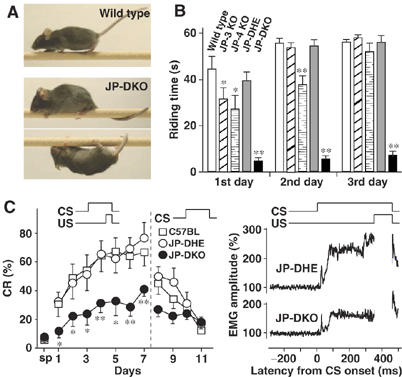Figure 1.

Poor performance of JP-DKO mice in cerebellar-dependent tasks. (A) In the fixed-bar test, JP-DKO mice showed abnormal behavior. The mouse was placed on a narrow bar and its behavior was photographed. (B) In the rota-rod test, JP-DKO mice failed to stay on a rotating rod. Mice were placed on a rod rotating at 16 r.p.m. for measuring their riding time in four trials for 3 days. A maximum of 60 s was allowed per trial. Mean±s.e.m. (wild type n=14, JP-3 KO n=7, JP-4 KO n=10, JP-DHE n=10, JP-DKO n=11; 8–9 weeks old). *P<0.05, **P<0.01, significantly different from the value for wild type (t-test). (C) In delay eyeblink conditioning, JP-DKO mice showed impaired performance. Conditioned response (CR) frequency of delay eyeblink conditioning (left panel). CS, intense sound as conditioned stimulus; US, electrical shock as unconditioned stimulus. After spontaneous eyeblink frequency (sp) was examined, mice were subjected to the acquisition session for 7 days and the extinction session for 4 days. Mean±s.e.m. (C57BL n=10, JP-DHE n=10, JP-DKO n=9; 7–10 weeks old). *P<0.05, **P<0.01, significantly different from the value for JP-DHE mice (t-test). No significant differences in performance were detected between C57BL and JP-DHE mice. The average amplitude of eyelid electromyography (EMG) on day 7 (right panel) is shown. The accumulated amplitude in JP-DKO mice is significantly lower than that in JP-DHE mice due to decreased CR%. The transient electromyographic response at ∼20 ms preceding the CR at ∼80–350 ms was derived from the auditory startle reflex elicited upon the sound and was retained in JP-DKO mice. Therefore, it is unlikely that the poor performance is caused by hearing inability in JP-DKO mice.
